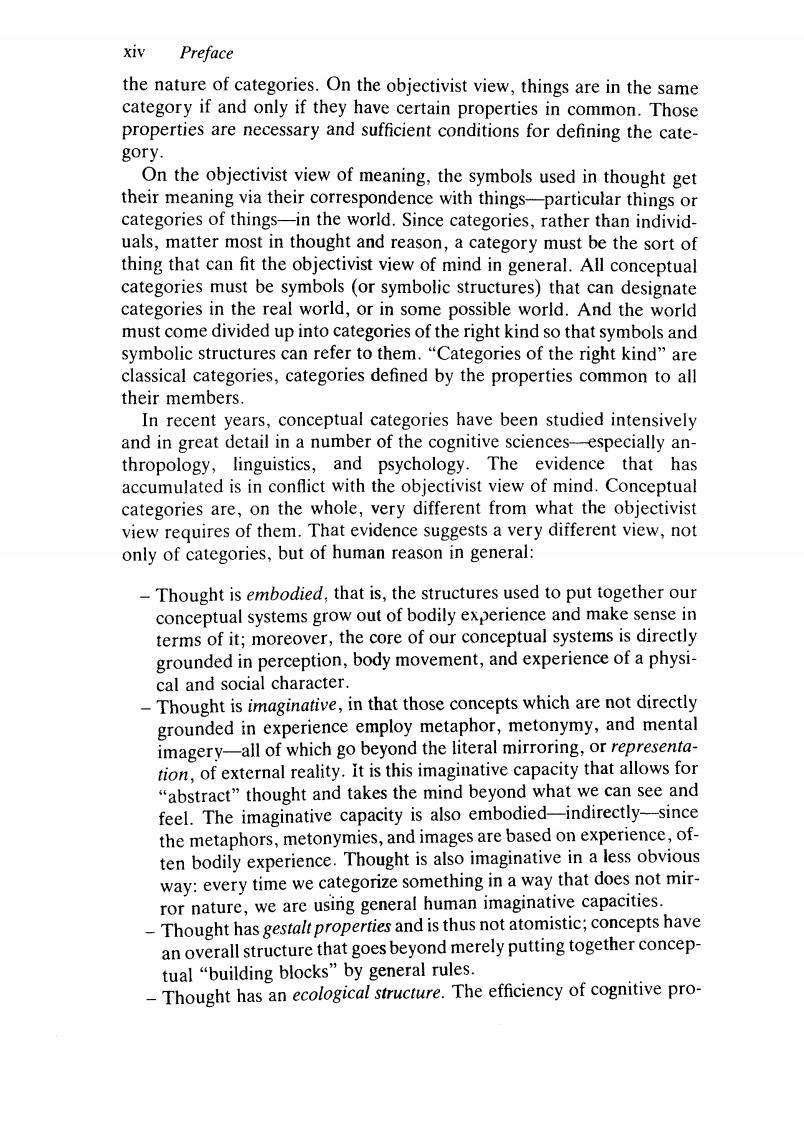正在加载图片...

xiv Preface the nature of categories.On the objectivist view,things are in the same category if and only if they have certain properties in common.Those properties are necessary and sufficient conditions for defining the cate- gory. On the objectivist view of meaning,the symbols used in thought get their meaning via their correspondence with things-particular things or categories of things-in the world.Since categories,rather than individ- uals,matter most in thought and reason,a category must be the sort of thing that can fit the objectivist view of mind in general.All conceptual categories must be symbols (or symbolic structures)that can designate categories in the real world,or in some possible world.And the world must come divided up into categories of the right kind so that symbols and symbolic structures can refer to them."Categories of the right kind"are classical categories,categories defined by the properties common to all their members. In recent years,conceptual categories have been studied intensively and in great detail in a number of the cognitive sciences-especially an- thropology,linguistics,and psychology.The evidence that has accumulated is in conflict with the objectivist view of mind.Conceptual categories are,on the whole,very different from what the objectivist view requires of them.That evidence suggests a very different view,not only of categories,but of human reason in general: -Thought is embodied,that is,the structures used to put together our conceptual systems grow out of bodily experience and make sense in terms of it;moreover,the core of our conceptual systems is directly grounded in perception,body movement,and experience of a physi- cal and social character. -Thought is imaginative,in that those concepts which are not directly grounded in experience employ metaphor,metonymy,and mental imagery-all of which go beyond the literal mirroring,or representa- tion,of external reality.it is this imaginative capacity that allows for "abstract"thought and takes the mind beyond what we can see and feel.The imaginative capacity is also embodied-indirectly-since the metaphors,metonymies,and images are based on experience,of- ten bodily experience.Thought is also imaginative in a less obvious way:every time we categorize something in a way that does not mir- ror nature,we are using general human imaginative capacities -Thought has gestalt properties and is thus not atomistic;concepts have an overall structure that goes beyond merely putting together concep- tual“building blocks”by general rules.. Thought has an ecological structure.The efficiency of cognitive pro-xiv Preface the nature of categories. On the objectivist view, things are in the same category if and only if they have certain properties in common. Those properties are necessary and sufficient conditions for defining the category. On the objectivist view of meaning, the symbols used in thought get their meaning via their correspondence with things-particular things or categories of things-in the world. Since categories, rather than individuals, matter most in thought and reason, a category must be the sort of thing that can fit the objectivist view of mind in general. All conceptual categories must be symbols (or symbolic structures) that can designate categories in the real world, or in some possible world. And the world must come divided up into categories of the right kind so that symbols and symbolic structures can refer to them. "Categories of the right kind" are classical categories, categories defined by the properties common to all their members. In recent years, conceptual categories have been studied intensively and in great detail in a number of the cognitive sciences~specially anthropology, linguistics, and psychology. The evidence that has accumulated is in conflict with the objectivist view of mind. Conceptual categories are, on the whole, very different from what the objectivist view requires of them. That evidence suggests a very different view, not only of categories, but of human reason in general: - Thought is embodied, that is, the structures used to put together our conceptual systems grow out of bodily eXyerience and make sense in terms of it; moreover, the core of our conceptual systems is directly grounded in perception, body movement, and experience of a physical and social character. _ Thought is imaginative, in that those concepts which are not directly grounded in experience employ metaphor, metonymy, and mental imagery-all of which go beyond the literal mirroring, or representation, of external reality. It is this imaginative capacity that allows for "abstract" thought and takes the mind beyond what we can see and feel. The imaginative capacity is also embodied-indirectly-since the metaphors, metonymies, and images are based on experience, often bodily experience. Thought is also imaginative in a less obvious way: every time we categorize something in a way that does not mirror nature, we are us'iog general human imaginative capacities. _ Thought has gestalt properties and is thus not atomistic; concepts have an overall structure that goes beyond merely putting together conceptual "building blocks" by general rules. _ Thought has an ecological structure. The efficiency of cognitive pro-